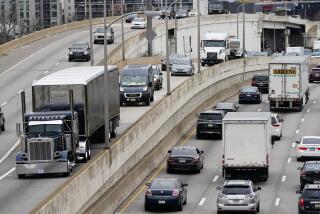Safety Experts Say Mismatches Need Study
- Share via
WINDSOR, Canada — A panel of international safety experts agreed Friday that vehicle mismatches in crashes are a growing worldwide concern but that more research is needed before design or regulatory changes should be imposed on auto makers.
More than a dozen safety officials from North America, Europe and Asia gave their views on vehicle compatibility at a meeting here organized by the National Highway Traffic Safety Administration.
The discussion was prompted by recent U.S. government research showing an increase in fatalities in crashes between light trucks--sport-utility vehicles, minivans and pickups--and passenger cars. Car occupants make up 80% of the fatalities in collisions between light trucks and cars.
The problem is most acute in the United States, where light trucks account for 34% of all vehicles on the road and nearly 50% of all new vehicle sales. Sport-utilities also are growing in popularity in Europe and parts of Asia, and more foreign auto makers are beginning to move into the segment.
In the four-hour dialogue at a Canadian hotel on the banks of the Detroit River, safety experts from auto companies, the insurance industry, universities and regulatory agencies agreed that the size and weight of light trucks help explain their lethality.
But mass is not the only thing determining a vehicle’s aggressiveness. Rather, design variables, including ride height and frame stiffness, are significant but little-understood factors, the experts agreed.
“There is a consensus that geometry is very important as well as stiffness,” said Brian O’Neill, president of the Insurance Institute for Highway Safety, an industry research group.
Adrian Hobbs, head of crash-worthiness for the Transport Research Laboratory, which conducts crash tests for the British government, said misalignment of structural frame members causes greater intrusion into the occupant compartment in a crash. A light truck with a higher, stiffer frame can penetrate deeply into a smaller car, inflicting more damage and injury than if the bumpers were the same height.
The Big Three U.S. auto makers--Chrysler, Ford and General Motors--presented a united front, delivering a spirited defense of their sales of light trucks as well as their efforts to improve overall vehicle safety.
Ernie Grush, a senior safety engineer for Ford, said the compatibility debate overlooks improvements in vehicle safety during the last two decades. An analysis by Ford shows that when late-model vehicles equipped with more safety equipment are involved in car-truck crashes, they better protect their occupants from serious injuries or fatalities than do older vehicles.
The Big Three are wary of making changes to light trucks that would diminish their safety and utility--major reasons consumers buy them.
Robert Lange, GM’s safety director, called for more cooperative research, including more crash testing and computer modeling, by government regulators and the auto industry. Lange also urged U.S. regulators to consider easing crash-test standards so that manufacturers could switch to softer truck frames.
“It’s premature to talk about any conclusions, premature to talk about design changes or about regulatory changes,” he said.






